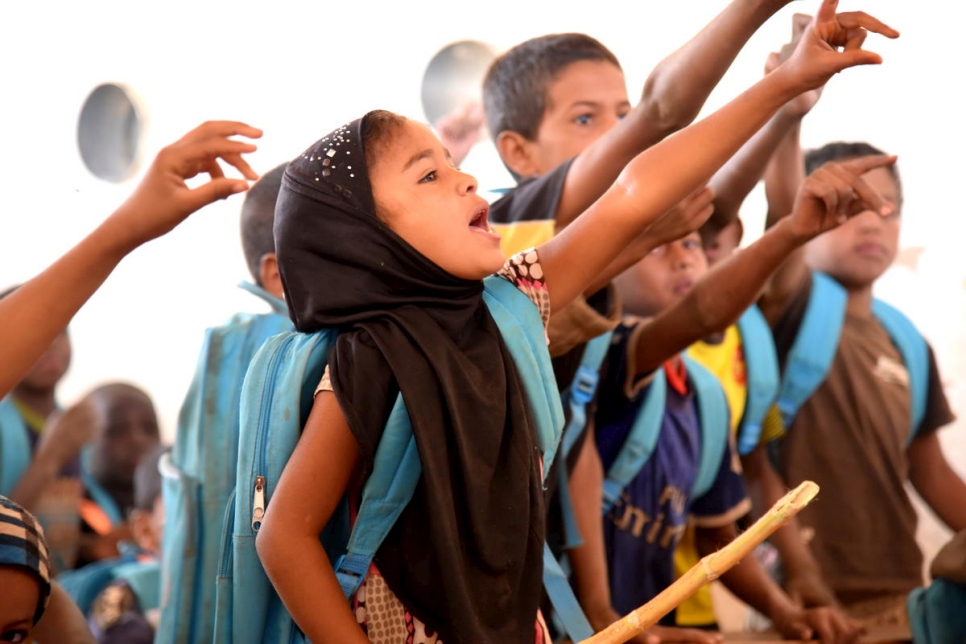Her Turn: UNHCR report reveals critical gap in education for refugee girls

Children compete to catch their teacher's attention in one of the six primary schools in Mbera refugee camp. In turn, they will read a text on the blackboard in front of their classmates. This exercise helps them to gain self-confidence by displaying their skills in public but also helps the whole class to memorize information. © UNHCR/Helena Pes
“Her Turn”, a new report from UNHCR, the UN Refugee Agency, reveals that refugee girls at secondary level are only half as likely to enrol in school as their male peers, even though girls make up half of the school-age refugee population.
Access to education is a fundamental human right. Yet, for millions of women and girls among the world's growing refugee population, education remains an aspiration, not a reality.
For all refugee children around the world, the school gates are a great deal harder to prise open than they are for their non-refugee peers. For refugee girls, it is even tougher to find – and keep – a place in the classroom. As they get older, refugee girls face more marginalization and the gender gap in secondary schools grows wider.
“It is time for the international community to recognize the injustice of denying refugee girls and women an education,” said Filippo Grandi, UN High Commissioner for Refugees. “These findings are a global wake-up call, and I urge all to join us in demanding: ‘It’s her turn’.”
UNHCR’s report reveals that social and cultural conventions often result in boys being prioritized over girls to attend school. Poor facilities such as a lack of appropriate toilet facilities and menstrual supplies can block refugee girls’ access to schools. Adding to the challenge, the cost of books, uniforms and the journey to school can be prohibitive for refugee families.
“Finding solutions to the challenges refugee girls face as they strive to go to school requires action right across the board – from national education ministries to teacher training institutions, in communities and classrooms,” added Grandi. “There are formidable barriers to overcome. We are calling for an international effort to turn the tide.”
To help more refugee girls get a quality education, UNHCR’s report highlights a number of actions and policies that are both effective and deliverable.
If refugee adults are able to work and support their families, they are more likely to let their children stay in school.
No girl should miss school because the journey to school is too far or too dangerous. Refugee girls need better protection from harassment, sexual assault and kidnap on the way to school.
There is also an urgent need to recruit and train more female teachers from within both host and refugee communities to ensure they promote best practice and guard against behaviour that will deter girls from setting foot in the classroom.
The report notes that for refugee girls, a quality education is protective. It reduces vulnerability to exploitation, sexual and gender-based violence, teenage pregnancy and child marriage. Additionally, if all women received a primary level education, child deaths from diarrhoea, malaria and pneumonia would fall.
Education is also empowering. The further girls progress with their schooling, the more they develop leadership skills, entrepreneurship, self-reliance and resilience.
These advantages are clearly illustrated by the individuals featured in the report – from the Burundian and Rwandan teenagers in Paysannat L School just outside Mahama refugee camp, who study alongside one another and who have become great friends, to the Rohingya teacher who devotes her evenings to teaching the many new arrivals from that community fleeing the violence in Myanmar.
“If we continue to neglect refugee girls’ education, it is evident that the consequences will be felt for generations,” said Grandi. “It is time to make refugee girls’ education a priority.”
Only 61 per cent of refugee children have access to primary education, compared to an international average of 91 per cent. At secondary level, 23 per cent of refugee adolescents go to school, compared to 84 per cent globally.
Media contacts
- In Geneva, Aikaterini Kitidi, kitidi@unhcr.org, +41 79 580 8334
- In New York, Kathryn Mahoney, mahoney@unhcr.org, +1 347 443 7646
